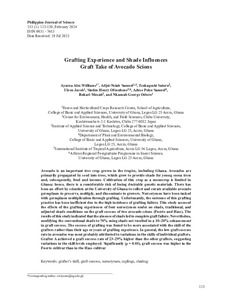| dc.contributor.author | Ayarna, A.W. |
| dc.contributor.author | Adjei-Nsiah, S. |
| dc.contributor.author | Tsukagoshi, S. |
| dc.contributor.author | Ulsen, J. |
| dc.contributor.author | Sintim, H.O. |
| dc.contributor.author | Aduse, P.S. |
| dc.contributor.author | Bukari, M. |
| dc.contributor.author | Nkansah, G.O. |
| dc.date.accessioned | 2024-03-13T13:17:10Z |
| dc.date.available | 2024-03-13T13:17:10Z |
| dc.date.issued | 2024-02 |
| dc.identifier.citation | Ayarna, A.W., Adjei-Nsiah, S., Tsukagoshi, S., Ulsen, J., Sintim, H.O., Aduse, P.S., ... & Nkansah, G.O. (2024). Grafting experience and shade influences graft take of avocado scions. Philippine Journal of Science, 153(1), 113-120. |
| dc.identifier.issn | 0031 - 7683 |
| dc.identifier.uri | https://hdl.handle.net/20.500.12478/8434 |
| dc.description.abstract | Avocado is an important tree crop grown in the tropics, including Ghana. Avocados are primarily propagated by seed into trees, which grow to provide shade for young cocoa trees and, subsequently, food and income. Cultivation of this crop as a monocrop is limited in Ghana; hence, there is a considerable risk of losing desirable genetic materials. There has been an effort by scientists at the University of Ghana to collect and curate available avocado germplasm to preserve, multiply, and disseminate to growers. Nurserymen have been tasked with germplasm multiplication through grafting. Unfortunately, the outcome of this grafting practice has been inefficient due to the high incidence of grafting failure. This study assessed the effects of the grafting experiences of four nurserymen under no shade, traditional, and adjusted shade conditions on the graft success of two avocado scions (Fuerte and Hass). The results of this study indicated that the absence of shade led to complete graft failure. Nevertheless, modifying the conventional shade to 70% using shade net resulted in a 10–20% enhancement in graft success. The success of grafting was found to be more associated with the skill of the grafters rather than their age or years of grafting experience. In general, the low graft success rate in avocados was most probably attributed to variations in the skills of individual grafters. Grafter A achieved a graft success rate of 23–29% higher than the other grafters, suggesting variations in the skill levels employed. Significantly (p = 0.05), graft success was higher in the Fuerte cultivar than in the Hass cultivar. |
| dc.format.extent | 113-120 |
| dc.language.iso | en |
| dc.subject | Avocados |
| dc.subject | Sampling |
| dc.subject | Shading |
| dc.title | Grafting experience and shade influences graft take of avocado scions |
| dc.type | Journal Article |
| cg.contributor.affiliation | University of Ghana |
| cg.contributor.affiliation | Chiba University |
| cg.contributor.affiliation | International Institute of Tropical Agriculture |
| cg.coverage.region | Africa |
| cg.coverage.region | West Africa |
| cg.coverage.country | Ghana |
| cg.coverage.hub | Headquarters and Western Africa Hub |
| cg.researchtheme | Natural Resource Management |
| cg.authorship.types | CGIAR and developing country institute |
| cg.iitasubject | Crop Systems |
| cg.iitasubject | Farming Systems |
| cg.iitasubject | Forestry |
| cg.iitasubject | Socioeconomy |
| cg.journal | Philippine Journal of Science |
| cg.notes | Open Access Article |
| cg.accessibilitystatus | Open Access |
| cg.reviewstatus | Peer Review |
| cg.usagerightslicense | Creative Commons Attribution 4.0 (CC BY 0.0) |
| cg.targetaudience | Scientists |
| cg.iitaauthor.identifier | Samuel Adjei-Nsiah: 0000-0002-7394-4913 |
| cg.futureupdate.required | No |
| cg.identifier.issue | 1 |
| cg.identifier.volume | 153 |

